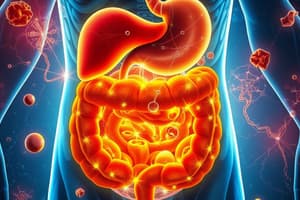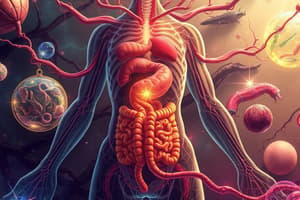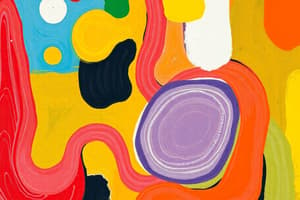Podcast
Questions and Answers
What triggers the release of antidiuretic hormone (ADH)?
What triggers the release of antidiuretic hormone (ADH)?
- Excessive loss of fluid from the body (correct)
- Increased blood pressure
- Excessive fluid retention
- Increased sodium concentration in blood
What effect does angiotensin II have on glomerular blood pressure?
What effect does angiotensin II have on glomerular blood pressure?
- Increases blood pressure (correct)
- Causes blood pressure to fluctuate
- Decreases blood pressure
- No effect on blood pressure
How does aldosterone affect kidney function?
How does aldosterone affect kidney function?
- Promotes urination
- Increases urine production
- Inhibits water reabsorption
- Facilitates reabsorption of Na+ and water (correct)
What role does Atrial Natriuretic Factor (ANF) play in kidney regulation?
What role does Atrial Natriuretic Factor (ANF) play in kidney regulation?
Which mechanism primarily regulates glomerular filtration rate (GFR) during low blood pressure?
Which mechanism primarily regulates glomerular filtration rate (GFR) during low blood pressure?
What physiological change signals the central nervous system to initiate micturition?
What physiological change signals the central nervous system to initiate micturition?
Which structure plays a key role in monitoring kidney function by releasing renin?
Which structure plays a key role in monitoring kidney function by releasing renin?
What activates osmoreceptors in the body?
What activates osmoreceptors in the body?
What role does the counter current mechanism play in the kidneys?
What role does the counter current mechanism play in the kidneys?
How does the flow of blood through the vasa recta correlate with the flow of filtrate in Henle's loop?
How does the flow of blood through the vasa recta correlate with the flow of filtrate in Henle's loop?
What substances contribute to the osmolarity gradient in the inner medulla?
What substances contribute to the osmolarity gradient in the inner medulla?
What is primarily transported by the ascending limb of Henle's loop?
What is primarily transported by the ascending limb of Henle's loop?
What does the counter current mechanism ultimately assist in regarding urine production?
What does the counter current mechanism ultimately assist in regarding urine production?
What is the typical osmolarity of urine compared to the initial filtrate formed?
What is the typical osmolarity of urine compared to the initial filtrate formed?
How does the thin segment of the ascending limb of Henle's loop contribute to urine concentration?
How does the thin segment of the ascending limb of Henle's loop contribute to urine concentration?
Which structures are primarily involved in the counter current mechanisms for maintaining osmolarity?
Which structures are primarily involved in the counter current mechanisms for maintaining osmolarity?
What is the primary function of the ascending limb of Henle's Loop?
What is the primary function of the ascending limb of Henle's Loop?
Which segment of the nephron is primarily responsible for the reabsorption of nearly all essential nutrients?
Which segment of the nephron is primarily responsible for the reabsorption of nearly all essential nutrients?
What role does the collecting duct play in urine concentration?
What role does the collecting duct play in urine concentration?
How does the descending limb of Henle's Loop affect the filtrate?
How does the descending limb of Henle's Loop affect the filtrate?
Which of the following substances is secreted by tubular cells during urine formation?
Which of the following substances is secreted by tubular cells during urine formation?
What is the unique property of the ascending limb of Henle's Loop regarding water?
What is the unique property of the ascending limb of Henle's Loop regarding water?
What percentage of water is reabsorbed in the proximal convoluted tubule (PCT)?
What percentage of water is reabsorbed in the proximal convoluted tubule (PCT)?
Which of these statements is true regarding the function of the distal convoluted tubule (DCT)?
Which of these statements is true regarding the function of the distal convoluted tubule (DCT)?
Flashcards
Countercurrent Mechanism
Countercurrent Mechanism
The loop of Henle and vasa recta work together to create a concentration gradient in the medulla, which helps to concentrate urine.
Descending Limb of Loop of Henle
Descending Limb of Loop of Henle
The descending limb of the loop of Henle is permeable to water, but not to salts. This allows water to move out of the tubule and into the interstitial fluid, concentrating the filtrate.
Ascending Limb of Loop of Henle
Ascending Limb of Loop of Henle
The ascending limb of the loop of Henle is impermeable to water, but actively pumps out salts. This increases the concentration of the interstitial fluid.
Vasa Recta
Vasa Recta
Signup and view all the flashcards
Collecting Duct
Collecting Duct
Signup and view all the flashcards
Urine Concentration
Urine Concentration
Signup and view all the flashcards
pH Regulation
pH Regulation
Signup and view all the flashcards
Ionic Balance
Ionic Balance
Signup and view all the flashcards
Kidney Function Regulation
Kidney Function Regulation
Signup and view all the flashcards
Osmoreceptors
Osmoreceptors
Signup and view all the flashcards
Antidiuretic Hormone (ADH)
Antidiuretic Hormone (ADH)
Signup and view all the flashcards
Juxtaglomerular Apparatus (JGA)
Juxtaglomerular Apparatus (JGA)
Signup and view all the flashcards
Renin
Renin
Signup and view all the flashcards
Angiotensin II
Angiotensin II
Signup and view all the flashcards
Aldosterone
Aldosterone
Signup and view all the flashcards
Atrial Natriuretic Factor (ANF)
Atrial Natriuretic Factor (ANF)
Signup and view all the flashcards
Reabsorption
Reabsorption
Signup and view all the flashcards
Secretion
Secretion
Signup and view all the flashcards
Proximal Convoluted Tubule (PCT)
Proximal Convoluted Tubule (PCT)
Signup and view all the flashcards
Loop of Henle
Loop of Henle
Signup and view all the flashcards
Distal Convoluted Tubule (DCT)
Distal Convoluted Tubule (DCT)
Signup and view all the flashcards
Study Notes
Excretory Products and Their Elimination
- Animals accumulate metabolic byproducts like ammonia, urea, uric acid, and various ions.
- These substances need to be removed either completely or partially.
- Ammonia is the most toxic form of nitrogenous waste, requiring significant water for elimination
- Uric acid, being the least toxic, can be eliminated with minimal water loss.
- Ammonotelism: Excretion of ammonia, common in bony fishes, aquatic amphibians, and aquatic insects. Ammonia is readily soluble and excreted by diffusion.
- Ureotelism: Excretion of urea, found in mammals, many terrestrial amphibians and marine fishes. Urea is less toxic than ammonia and requires less water loss.
- Uricotelism: Excretion of uric acid; characteristic of reptiles, birds, land snails, and insects. Uric acid forms a paste or pellet, minimizing water loss.
Human Excretory System
- The human excretory system comprises a pair of kidneys, ureters, a urinary bladder, and urethra.
- Kidneys are bean-shaped organs situated between the last thoracic and third lumbar vertebrae.
- Each kidney contains approximately one million nephrons, the functional units of the kidney.
- Nephrons: Composed of glomerulus and renal tubule.
- Glomerulus: A tuft of capillaries.
- Renal Tubule: Begins with Bowman's capsule enclosing the glomerulus. The tubule coils and forms convoluted sections (PCT, DCT). The loop of Henle is a hairpin loop, extending into the medulla in some nephrons.
- The glomerulus filters blood, forming a filtrate.
- Blood is filtered in the glomerular capillary network, forming a filtrate that is collected in Bowman's capsule.
- PCT helps in reabsorption of essential nutrients, electrolytes, and water.
- Loop of Henle plays a vital role in concentrating the filtrate.
- DCT allows reabsorption of Na+, water, and HCO₃, secretion of H⁺ and K⁺.
Urine Formation
- Urine formation is a three-step process: glomerular filtration, reabsorption, and secretion.
- Glomerular filtration: Blood is filtered by the glomerulus in the Bowman's capsule. This forms a protein-free filtrate.
- Reabsorption: The renal tubules selectively reabsorb essential substances and water from the filtrate.
- Secretion: Tubular cells actively secrete substances like H+, K+, and ammonia into the filtrate.
- Approximately, 1100-1200 ml of blood is filtered every minute.
Regulation of Kidney Function
- Osmoreceptors in the hypothalamus respond to changes in blood volume and concentration.
- ADH (antidiuretic hormone): Controls water reabsorption in the distal convoluted tubule.
- JGA (juxta glomerular apparatus): Regulates glomerular filtration rate (GFR). It plays a crucial role in maintaining blood pressure.
- Renin-angiotensin system: A complex mechanism involving renin, angiotensin, and aldosterone to regulate blood pressure and Na⁺ and water balance.
- ANF (atrial natriuretic factor): Released by the heart in response to increased blood pressure, counteracts the renin-angiotensin system.
Micturition
- Urine is stored in the urinary bladder.
- The CNS initiates the expulsion of urine by triggering the contraction of bladder muscles and relaxation of the sphincter.
Studying That Suits You
Use AI to generate personalized quizzes and flashcards to suit your learning preferences.
Related Documents
Description
This quiz covers the different types of excretory products found in animals, including ammonia, urea, and uric acid, and their methods of elimination. It also explores the human excretory system, highlighting the anatomy and function of organs such as the kidneys and urinary bladder.




